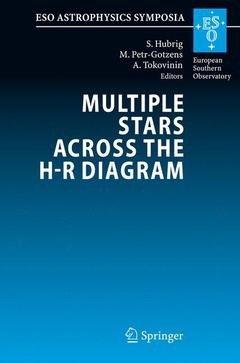Multiple Stars across the H-R Diagram, Softcover reprint of hardcover 1st ed. 2008 Proceedings of the ESO Workshop held in Garching, Germany, 12-15 July 2005 ESO Astrophysics Symposia Series
Langue : Anglais
Coordonnateurs : Hubrig Swetlana, Petr-Gotzens Monika, Tokovinin Andrei

The ESO workshop ?Multiple Stars across the H-R Diagram? was held in Garching on 12?15, July 2005. The topics included observations of multiple stars from ground and space, dynamical and stellar evolution in multiple systems, e?ects of the environment on multiplicity, formation and early e- lution of multiple stars, and special components of multiple stars (chemically peculiar stars, blue stragglers, brown dwarfs, etc.). Stars show a marked tendency to be in systems of di?erent multiplicity, 7 ranging from simple binaries and triples to globular clusters with N?10 . Modern observations give a frequency of binary and multiple stars in the Galactic ?eld of up to 70%, and between 5% and 20% of these systems are at least triple. There is evidence that the degree of multiplicity increases with primary mass. Many known multiple systems are too wide to have s- ni?cant physical interaction between their components. However, tidal and N-body dynamical interactions are important even in relatively wide s- tems and probably lead to the shrinkage of inner orbits. This sets the stage for spectacular evolutionary processes such as Roche-lobe over?ow, me- ers, supernovae, formation of special components, etc. Only recently did we realize that some of these processes require at least three stars. Theformationofmultiplesystemsremainsadi?cultandchallengingpart of astrophysics, although it has been addressed at the Workshop only brie?y.
Evolutionary Processes in Multiple Systems.- Dynamics and Stability of Triple Stars.- Multiple Stars: Physics vs. Dynamics.- Gliese 225.2: An Old (Stable?) Quadruplet.- Multiple Stars: Designation, Catalogues, Statistics.- Radial-velocity Studies of Certain Multiple Systems.- Spectral Disentangling Applied to Triple Systems: RV Crt.- Evidence for Rapid Variability in the Multiple System 68 u Her.- DG Leo: A Triple System with a Surprising Variety of Physical Phenomena.- A Spectroscopic Study of HD 208905.- The Suspected Binarity of the Nearby Flare Star Gl 424.- The Ecology of Dense Star Clusters with Binaries.- The Formation of Multiple Stars.- Population of Dynamically Formed Triples in Dense Stellar Systems.- Interferometric Studies of Multiple Stars.- Interferometric Orbits of New Hipparcos Binaries.- New Facts about ? Velorum: Fewer but Larger Components.- Speckle Interferometry of Two Low-mass Triple Systems in the Solar Neighbourhood.- Tertiary Companions to Close Spectroscopic Binaries.- Spectroscopic Subcomponents in Visual Double Stars: The Most Probable Values of their Physical and Orbital Parameters.Application to the System WDS 14404+2159.- Multiple Stars in the Field.- Multiplicity of Chemically Peculiar Stars.- Multiplicity of Contact Binary Stars.- Extrasolar Planets in Double and Multiple Stellar Systems.- Homogeneous Comparison of Directly Detected Planet Candidates: GQ Lup, 2M1207, AB Pic.- Searching for Planets Around Stars in Wide Binaries.- Multiplicity at the Very Low Mass End of the H-R Diagram.- Spectroscopic Companions of Very Young Brown Dwarfs.- The Observed Multiplicity of Low-mass Stars: From Embedded Protostars to Open Clusters.- High-order Multiplicity of PMS Stars: Results from a VLT/NACO Survey.- Accretion onto Binary YSOs Through Gapfrom Their Circum-binary Disk.- The Nearest Pre-Main Sequence Multiple Stars.- A Study of the Young Quadruple System AO Vel with a ZAMS Eclipsing BpSi Primary and PMS Companions.- Multiplicity of Massive Stars.- The Triple System ?1 Orionis A in the Heart of the Orion Trapezium Cluster.- The Primordial Binary Population in OB Associations.- Multiplicity of Early-type Stars in the Field: Progress Report.- Search for Low-mass Companions to X-ray Emitting A-type Stars.
Reviews current state of observational and theoretical knowledge of Multiple Stars Discusses future studies for further progress in the field
Date de parution : 11-2010
Ouvrage de 305 p.
15.5x23.5 cm
Date de parution : 10-2007
Ouvrage de 305 p.
15.5x23.5 cm
Thème de Multiple Stars across the H-R Diagram :
Mots-clés :
Accretion; Binary Stars; Exoplanets; Globular Clusters; Interferometry; Multiple Stars; Spectroscopy; Star; Stellar Clusters; stellar
© 2024 LAVOISIER S.A.S.



